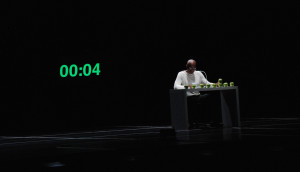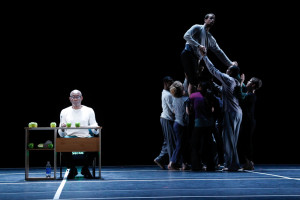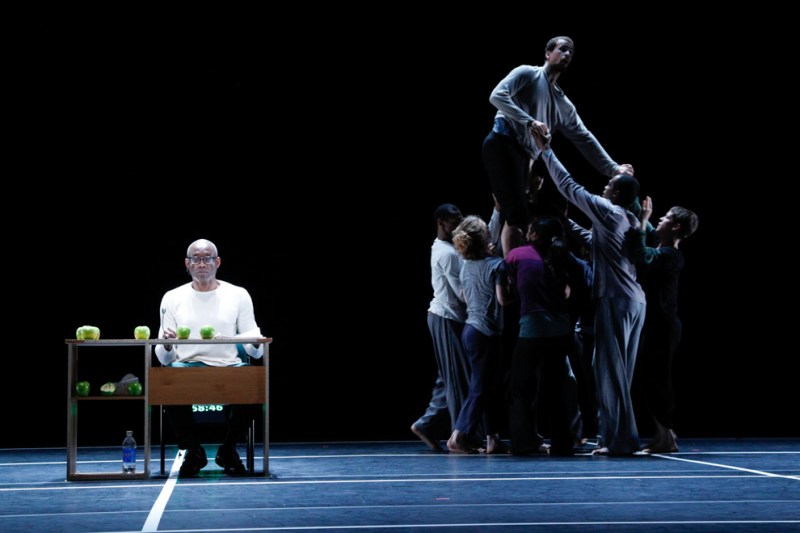
0:01, 0:02, 0:03. The bold, green numbers ticked upward on the black, rectangular clock behind Bill T. Jones as he began his 40th performance of “Story/Time” last Friday. A multidisciplinary work incorporating storytelling and choreography, “Story/Time” is the telling of 70, one-minute vignettes written and narrated by Jones. Through these stories, Jones and the Bill T. Jones/Arnie Zane Dance Company tested the boundaries of what qualifies as dance and theater at Memorial Auditorium.
Bill T. Jones and Arnie Zane founded the Bill T. Jones/Arnie Zane Dance Company together in 1983. They dreamed of challenging notions about what kind of bodies belong on stage and how dancing should look. Drawing from both John Cage’s “Indeterminacy” and contact improvisation — a postmodern style of dance focused on bodily awareness and the point of physical contact between two dancers — Jones and Zane gained international renown for their experimental theater-dance hybrid. Zane, Bill T. Jones’ dance partner and lover, sadly passed away in 1988, but Jones continues to engage his passion for performance even now, at the age of 62.
As the narrator, Jones played an integral role in “Story/Time.” Smooth and deep like molasses, Jones’ voice reverberated through the auditorium as he recounted 70 different stories, each exactly one minute long. Jones’ appreciation for silence augmented the narration of these vignettes. Most storytellers shy away from silence because they think that it will interrupt their flow; however, Jones embraces it, modeling his storytelling technique after that of John Cage, a composer who esteemed silence to be equal with sound. Oddly enough, the most poignant moments in Jones’ narration were the ones in which he said nothing.

Orbiting the cool, self-assured Jones, nine dancers echoed his narrations with distinctively fluid and interconnected movements. Lunging, sweeping their arms about and rolling over one another gracefully, the dancers, who seemed more concerned with letting their bodies speak than with conveying any particular message, captivated the audience’s attention.
From time to time, these dancers dragged out minimalist set pieces to complement their choreography. Several times, they brought out a translucent, white wall that framed their movements and added a new dimension of color to their performance. While the dancers occasionally interacted with a couch or a chair, Jones sat, from beginning to end, in a small chair behind a plain desk, which was lined with a row of green apples; the color of which mirrored the eerie, green tint of the clock.
At Jones’ feet, lines of white tape divided the stage into 12, neat squares. Though the dancers were not limited to dancing within one particular square at any time, each square generally contained a scene separate from those of its neighbors. Illuminating these squares, the lights of Memorial Auditorium shined a pale spotlight on the areas in which action was occurring. Sometimes, however, lighting designer Robert Wierzel coordinated the lighting so that it deviated from its spotlighting role, lighting the stage in a terrifying shade of red.
In these moments, the audio, which normally consisted of Jones’ soothing voice, shifted dramatically to a barrage of static and extraneous noise, like something out of the soundtrack to “The Shining.” These short bursts of clamor — supervised by sound designer Sam Crawford — were as profound as they were unnerving.
Once 68 minutes had elapsed, the clock descended from its obscured position, to which it had ascended at the 10-minute mark to avoid drawing attention. As the clocked approached 70 minutes, I realized that I had registered very little of what Jones had said; I had been listening, but I had been so distracted by the aesthetic of it all that I had forgotten to process what his words meant. To a certain extent, I feel like this may have been Jones’ intention. Finally, the clock struck 70 minutes; Jones and company took their final bow. I left the theater without a clear idea of what I had just witnessed, but felt satisfied nonetheless.
Contact Ian Anstee at ianstee5 ‘at’ stanford.edu.
